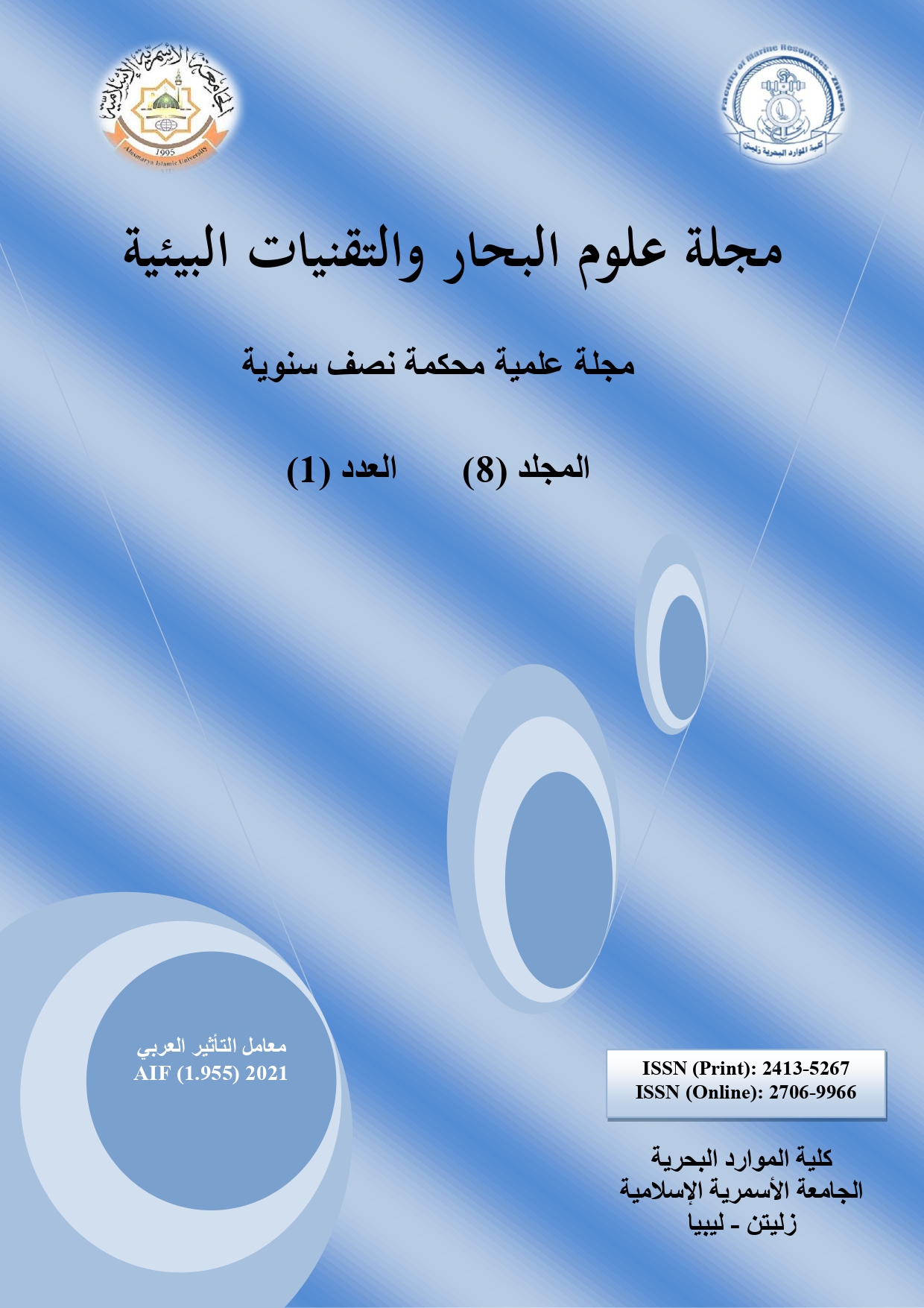العلاقة بين مفهوم الميناء الأخضر والقدرة التنافسية (دراسة تطبيقية مقارنة لميناء طرابلس)
DOI:
https://doi.org/10.59743/jmset.v8i1.6الكلمات المفتاحية:
التنافسية، المتطلبات البيئية، الكفاءة، الموانئ الخضراءالملخص
تعمل الموانئ البحرية في بيئة دائمة التغير؛ حيث تتوسع التغييرات والتحديات، ويرجع ذلك أساسًا إلى اتجاهات التجارة العالمية وتطورات الصناعة. لذلك يجب أن تظل الموانئ البحرية مبتكرة وجاهزة لمواكبة هذه التغييرات والمشاركة فيها. بالإضافة إلى ذلك، تتجه معظم دول العالم نحو جعل موانئها خضراء لزيادة قدرتها التنافسية وجعلها خالية من التلوث. يهدف البحث إلى تحويل ميناء طرابلس من ميناء تقليدي إلى ميناء أخضر لزيادة قدرته التنافسية بين موانئ البحر الأبيض المتوسط الأخرى وذلك عن طريق عرض الدراسات السابقة الخاصة بموضوع الدراسة.
التنزيلات
المراجع
Beels C. (2009). Optimization of the lay-out of a farm of wave energy converters in the North Sea: Analysis of wave power resources, wake effects, production and cost. Ph.D. thesis. Department of Civil Engineering, Ghent University.
Beels C., Troch P., De Visch K., Kofoed J.P., and De Backer G. (2010). Application of the time-dependent mild-slope equations for the simulation of wake effects in the lee of a farm of wave dragon wave energy converters. Renewable Energy, 35(8): 1644–1661.
Burcharth H.F., Zanuttigh B., Andersen T.L., Lara J.L., Steendam G.J., Ruol P., ... & Higuera P. (2015). Innovative engineering solutions and best practices to mitigate coastal risk. In: Coastal risk management in a changing climate. Butterworth-Heinemann., pp. 55-170.
Dean R.G. and Dalrymple R.A. (1991). Water wave mechanics for engineers and scientists, Vol. 2. World Scientific Publishing Company, Singapore.
Diaconu S. and Rusu E. (2013). The environmental impact of a wave dragon array operating in the Black Sea. Sci. World J., 498013.
Diamantoulaki I. and Angelides D.C. (2011). Modeling of cable-moored floating breakwaters connected with hinges. Eng. Struct., 33(5): 1536–1552.
Dong G., Zheng Y., Li Y., Teng B., Guan C., and Lin D. (2008). Experiments on wave transmission coefficients of floating breakwaters. Ocean Eng., 35(8): 931–938.
Goggins J. and Finnegan W. (2014). Shape optimisation of floating wave energy converters for a specified wave energy spectrum. Renewable Energy, 71: 208–220.
Hales L.Z. (1981). Floating breakwaters: State-of-the-art literature review. Technical Rep. TR81-1. United States Army Corps of Engineers, Springfield, VA.
He F., Huang Z., and Law A.W. (2012). Hydrodynamic performance of a rectangular floating breakwater with and without pneumatic chambers: An experimental study. Ocean Eng., 51: 16–27.
Holthuijsen L.H. (2010). Waves in oceanic and coastal waters. Cambridge University Press, Cambridge, U.K.
Ji C., Chen X., Cui J., Yuan Z., and Incecik A. (2015). Experimental study of a new type of floating breakwater. Ocean Eng., 105: 295–303.
Kramer M.M. & Frigaard P.B. (2002). Efficient wave energy amplification with wave reflectors. Proc. 12th Int. Offshore and Polar Eng. Conf., Kitakyushu, Japan, 707–712.
Kriebel D.L. & Bollmann C.A. (1996). Wave transmission past vertical wave barriers. Proc. 25th Int. Conf. on Coastal Eng. (ICCE), ASCE, Reston, Va., 2470–2483.
Koutandos E., Prinos P., and Gironella X. (2005). Floating breakwaters under regular and irregular wave forcing: Reflection and transmission characteristics. J. Hydraulic Res., 43(2): 174–188.
Li D., Panchang V., Tang Z., Demirbilek Z., and Ramsden J. (2005). Evaluation of an approximate method for incorporating floating docks in harbor wave prediction models. Can. J. Civ. Eng., 32(6): 1082–1092.
Macagno E.O. (1954). Houle dans un canal présentant un passage en charge. La Houille Blanche, 1(1): 10–37 (in French).
Martinelli L., Ruol P., and Zanuttigh B. (2008). Wave basin experiments on floating breakwaters with different layouts. Appl. Ocean Res., 30(3): 199–207.
McCartney B.L. (1985). Floating breakwater design. J. Waterway Port Coastal Ocean Eng., 111(2): 304–318.
Ning D., Zhao X., Göteman M., and Kang H. (2016). Hydrodynamic performance of a pile-restrained WEC-type floating breakwater: An experimental study. Renewable Energy, 95: 531–541.
Nørgaard J.H. & Andersen T. L. (2012). Investigation of wave transmission from a floating wave dragon wave energy converter. 22nd Int. Offshore and Polar Eng. Conf., International Society of Offshore and Polar Engineers.
Oliver J., Aristaghes P., Cederwall K., Davidson D., De Graaf F., Thackery M., and Torum A. (1994). Floating breakwaters: A practical guide for design and construction. PIANC Report, Working Group 13, Permanent International Association of Navigation Congresses, Belgium.
Palha A., Mendes L., Fortes C.J., Brito-Melo A., and Sarmento A. (2010). The impact of wave energy farms in the shoreline wave climate: Portuguese pilot zone case study using pelamis energy wave devices. Renewable Energy, 35(1): 62–77.
Ruol P., Martinelli L., and Pezzutto P. (2013). Formula to predict transmission for π-type floating breakwaters. J. Waterway Port Coastal Ocean Eng., 1–8.
Ruol P., Martinelli L., and Pezzutto P. (2013). Limits of the new transmission formula for pi-type floating breakwaters. Coastal Eng. Proc., 1(33): 47.
Ruol P., Zanuttigh B., Martinelli L., Kofoed P., and Frigaard P. (2011). Near-shore floating wave energy converters: Applications for coastal protection. Coastal Eng. Proc., 1(32): 61.
Sorensen R.M. (2005). Basic coastal engineering. Springer Science & Business Media, Berlin/Heidelberg, Germany.
Tsay T.K. & Liu P.L. (1983). A finite element model for wave refraction and diffraction. Applied Ocean Research, 5(1): 30-37.
Türker U. & Kabdasli M. (2004). Average sediment dislocation analysis for barred profiles. Ocean Eng., 31(14): 1741–1756.
Türker U. (2014). Excess energy approach for wave energy dissipation at submerged structures. Ocean Eng., 88: 194–203.
Ursell F. (1947). The effect of a fixed vertical barrier on surface waves in deep water. Math. Proc. Cambridge, 43(3): 374–382.
Venugopal V. & Smith G.M. (2207). Wave climate investigation for an array of wave power devices. Proceedings of the 7th European wave and tidal energy conference, Porto, Portugal, 11-14.
Wiegel R.L. (1960). Transmission of waves past a rigid vertical thin barrier. J. Waterways Harbors Div., 86(1): 1–12.
التنزيلات
منشور
إصدار
القسم
الرخصة
الحقوق الفكرية (c) 2022 مجلة علوم البحار والتقنيات البيئية

هذا العمل مرخص بموجب Creative Commons Attribution 4.0 International License.












